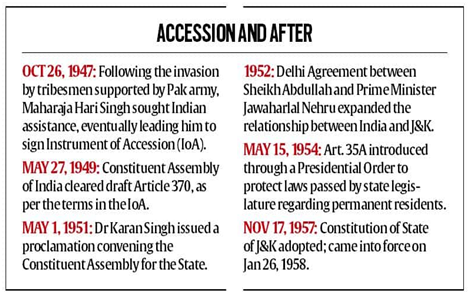Why in News?
- The Union Territory of J&K has witnessed many firsts in the past four years after removal of its special status under Article 370 in August, 2019.
- According to the Ministry of Home Affairs (MHA), the abrogation of Article 370 had paved the way for peace and development in J&K.
What’s in Today’s Article?
- Article 370 of the Indian Constitution (Background, Features, Removal, Consequences, etc.)
- Political Changes in J&K in the past 4 years
- Challenges that Need to be Addressed in J&K
Article 370 of the Indian Constitution:

- Article 370 is the first article of Part XXI of the Constitution - ‘Temporary, Transitional and Special Provisions’.
- It exempts J&K from the application of the Constitution of India (except Article 1 and Article 370 itself) and permits the state to draft its own Constitution.
- It restricts Parliament’s legislative powers in respect of J&K and for extending a central law on subjects included in the Instrument of Accession (IoA), mere “consultation” with the state government is needed.
- IoA was signed by Raja Hari Singh of the then princely state of J&K and Governor General Lord Mountbatten in 1947.
- The IoA gave Parliament the power to legislate in respect of J&K only on Defence, External Affairs and Communications.
- But for extending it to other matters, “concurrence” of the state government is mandatory.
- Article 370 had been described as a tunnel through which the Constitution was applied to J&K.
- By the 1954 order, almost the entire Constitution was extended to J&K including most Constitutional amendments.
Removal of Special Status of J&K:
- Article 370(3) permits deletion of special status of J&K by a Presidential Order.
- Such an order, however, is to be preceded by the concurrence of J&K’s Constituent Assembly.
- Since such an Assembly was dissolved on January 26, 1957, one view is that special status cannot be removed.
- But the other view is that it can be done, only with the concurrence of the State Assembly.
- In 2019, the Constitution (Application to Jammu and Kashmir) Order 2019, issued by the President, withdrew the special status of J&K and extended all provisions of the Indian Constitution to J&K.
- The J&K (Reorganization) Act 2019 bifurcated J&K into two UTs - J&K was an UT with a Legislative Assembly; Ladakh was without an Assembly.
- Recently, the Supreme Court of India began hearing the petitions challenging the 2019 abrogation of Article 370.
Many firsts in the past 4 years in J&K:
- Establishment of all three tiers of Panchayati Raj
- Reservation of seats for Scheduled Tribes (STs) during the delimitation of Assembly constituencies.
- A change in domicile laws to enable people from elsewhere in the country to settle in J&K.
How has been the Security Situation in J&K in the past 4 years?
- No more stone pelting: With the unprecedented numbers of security forces in the Valley, and the harsh action taken by central agencies such as the NIA, incidents of stone throwing have been reduced to virtually zero.
- Incidents of terrorism have witnessed a steep decline: Government data show a decline of 32% in “acts of terrorism” between August 5, 2019 and June 6, 2022, compared with the 10 months preceding the historic decisions.
Political Changes in J&K in the past 4 years:
- District Council elections:
- Elections were held to District Development Councils (DDCs) in all 20 districts of J&K in 2020, raising hopes for a democratic process at the grassroots.
- DDCs in J&K were earlier called District Planning and Development Boards, with members who were nominated by the state government.
- Political realignments:
- Almost all major opposition leaders were either detained or had their movements curtailed after the abrogation of Article 370.
- With political actions by mainstream parties frozen, new outfits emerged, and several leaders changed loyalties. For example, PDP joined hands with NC.
- Delimitation Commission:
- The Centre constituted a 3-member Commission under retired SC judge Justice Ranjana Desai in 2020 to carve out 90 Assembly constituencies, including reserved ones for SCs and STs.
- In its final report in 2022, the commission increased the number of Assembly seats in Jammu division from 37 to 43 and in Kashmir from 46 to 47.
- It also recommended reservation of 9 constituencies for STs, 6 for SCs, and a provision for nomination of two Kashmiri Hindus and a displaced person from PoK.
Challenges that Need to be Addressed in J&K:
- Grassroot democracy is still not a reality: DDC chairpersons have complained that in most cases the development plans are prepared by officials.
- Polls, quotas, and protests:
- The delimitation exercise led to speculation about early Assembly elections. However, there is very little chance of elections being held before next year’s Lok Sabha polls.
- Meanwhile, the Centre’s attempt to include four new groups in the state’s ST list triggered widespread demonstrations from the Gujjars and Bakerwals.
- Targeted killings: A spate of killings of civilians, especially of Kashmiri Hindus and non-Kashmiris in the Valley, has exposed the fragility of the security successes.
- Cross-border terrorism: The targeted killings have been aided by the dropping of small weapons by low-cost drones from across the border, and the engagement of alleged ‘part-time’ militants by handlers in Pakistan.









